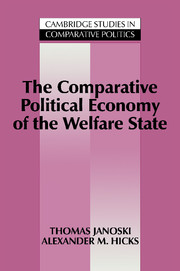Book contents
- Frontmatter
- Contents
- List of contributors
- List of tables and figures
- Preface
- 1 Methodological innovations in comparative political economy: an introduction
- PART I TIME-SERIES ANALYSIS
- PART II POOLED TIME-SERIES AND CROSS-SECTIONAL ANALYSIS
- 6 Introduction to pooling
- 7 The social democratic corporatist model of economic performance in short- and medium-run perspective
- 8 National variation in the fortunes of labor: a pooled and cross-sectional analysis of the impact of economiccrisis in the advanced capitalist nations
- PART III EVENT HISTORY ANALYSIS
- PART IV BOOLEAN ANALYSIS
- Author index
- Subject index
6 - Introduction to pooling
Published online by Cambridge University Press: 05 June 2012
- Frontmatter
- Contents
- List of contributors
- List of tables and figures
- Preface
- 1 Methodological innovations in comparative political economy: an introduction
- PART I TIME-SERIES ANALYSIS
- PART II POOLED TIME-SERIES AND CROSS-SECTIONAL ANALYSIS
- 6 Introduction to pooling
- 7 The social democratic corporatist model of economic performance in short- and medium-run perspective
- 8 National variation in the fortunes of labor: a pooled and cross-sectional analysis of the impact of economiccrisis in the advanced capitalist nations
- PART III EVENT HISTORY ANALYSIS
- PART IV BOOLEAN ANALYSIS
- Author index
- Subject index
Summary
Imagine that you wish to investigate the macroeconomic impacts of government wage–price controls. However, you have data for only a dozen years on each of a handful of nations, and you fear that you have insufficient observations for competent analysis. Or imagine that you wish to test a model of voluntary wage restraint that stresses impacts of inflation and proportional representation (a bulwark of the consensual mode of governance). Unfortunately, you think, inflationary dynamics that must be studied over time and proportional representation, which varies only across nations during years of interest, seem incompatible with a single study. Neither cross-sectional nor time-series data seem adequate to the task of studying both inflationary dynamics and proportional representation at one and the same time.
Pooled data, which range across time and space, may enable you to overcome your difficulties. Pooled data are arrayed across both crosssectionally differentiated entities like nations and temporally differentiated ones like years. Thus, they tap variance both in temporally inert variables such as proportional representation and in more temporally lively ones like inflation rates. Intersections of time and space such as the “nation–year” serve as units of analysis in pooled data arrays. Such “place–time” marriages of data multiply numbers of observations. Thanks to pooling, it may be possible after all to find data with the axes of variation and the numbers of observations that you need.
- Type
- Chapter
- Information
- The Comparative Political Economy of the Welfare State , pp. 169 - 188Publisher: Cambridge University PressPrint publication year: 1994
- 53
- Cited by

